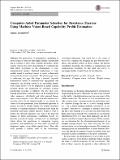Computer-aided parameter selection for resistance exercise using machine vision-based capability profile estimation
Abstract
The penetration of mathematical modelling in sports science to date has been highly limited. In particular and in contrast to most other scientific disciplines, sports science research has been characterized by comparatively little effort investment in the development of phenomenological models. Practical applications of such models aimed at assisting trainees or sports professionals more generally remain nonexistent. The present paper aims at addressing this gap. We adopt a recently proposed mathematical model of neuromuscular engagement and adaptation, and develop around it an algorithmic framework which allows it to be employed in actual training program design and monitoring by resistance training practitioners (coaches or athletes). We first show how training performance characteristics can be extracted from video sequences, effortlessly and with minimal human input, using computer vision. The extracted characteristics are then used to fit the adopted model i.e. to estimate the values of its free parameters, from differential equations of motion in what is usually termed the inverse dynamics problem. A computer simulation of training bouts using the estimated (and hence athlete specific) model is used to predict the effected adaptation and with it the expected changes in future performance capabilities. Lastly we describe a proof-of-concept software tool we developed which allows the practitioner to manipulate training parameters and immediately see their effect on predicted adaptation (again, on an athlete specific basis). Thus, this work presents a holistic view of the monitoring–assessment–adjustment loop which lies at the centre of successful coaching. By bridging the gap between theoretical and applied aspects of sports science, the present contribution highlights the potential of mathematical and computational modelling in this field and serves to encourage further research focus in this direction.
Citation
Arandelovic , O 2017 , ' Computer-aided parameter selection for resistance exercise using machine vision-based capability profile estimation ' , Augmented Human Research , vol. 2 , 4 . https://doi.org/10.1007/s41133-017-0007-1
Publication
Augmented Human Research
Status
Peer reviewed
ISSN
2365-4317Type
Journal article
Collections
Items in the St Andrews Research Repository are protected by copyright, with all rights reserved, unless otherwise indicated.
Related items
Showing items related by title, author, creator and subject.
-
Virtual Worlds and the 3D Web – time for convergence?
Bakri, Hussein; Allison, Colin; Miller, Alan Henry David; Oliver, Iain Angus (Springer, 2016) - Conference itemMulti-User Virtual Worlds (MUVW) such as Open Wonderland and OpenSim have proved to be fruitful platforms for innovative educational practice, supporting exploratory learning and generating true engagement. However, when ... -
Studying programmer behaviour at scale : a case study using Amazon Mechanical Turk
Jacques, Jason T.; Kristensson, Per Ola (ACM, 2021-03-22) - Conference itemDeveloping and maintaining a correct and consistent model of how code will be executed is an ongoing challenge for software developers. However, validating the tools and techniques we develop to aid programmers can be a ... -
Investigating the accessibility of crowdwork tasks on Mechanical Turk
Uzor, Stephen; Jacques, Jason T.; Dudley, John J.; Kristensson, Per Ola (ACM, 2021-05-06) - Conference itemCrowdwork can enable invaluable opportunities for people with disabilities, not least the work fexibility and the ability to work from home, especially during the current Covid-19 pandemic. This paper investigates how ...

